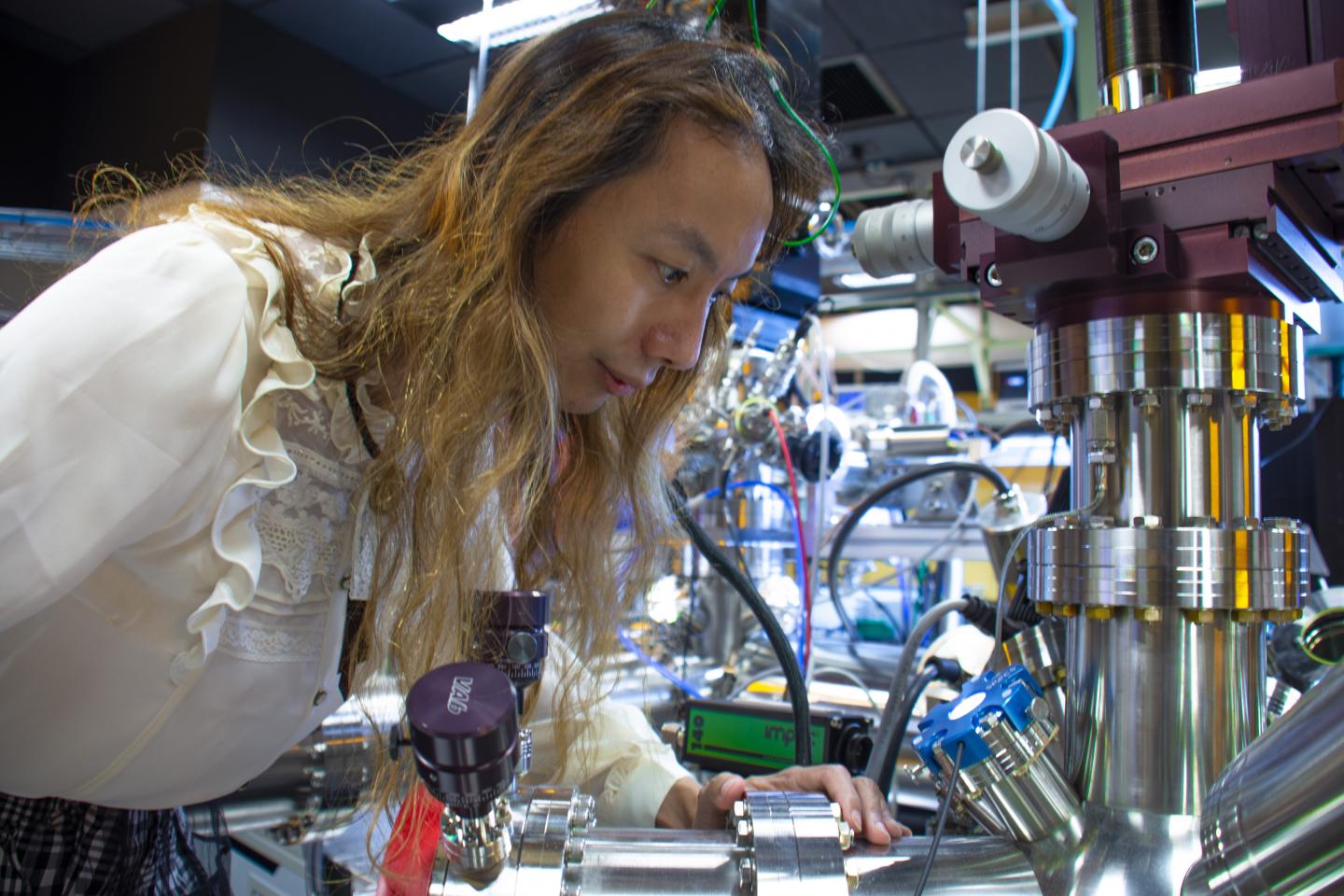Researchers pioneer a revolutionary new method to directly observe previously hidden particles, called dark excitons.

Credit: OIST
Heralding the end of a decade-long quest, in a promising new class of extremely thin, two-dimensional semiconductors, scientists have for the first time directly visualized and measured elusive particles, called dark excitons, that cannot be seen by light.
The powerful technique, described in leading journal Science, could revolutionize research into two-dimensional semiconductors and excitons, with profound implications for future technological devices, from solar cells and LEDs to smartphones and lasers.
Excitons are excited states of matter found within semiconductors – a key ingredient in many current technologies. They form when electrons in the semiconductor material are excited by light to a higher energy state, leaving behind a “hole” at the energy level where the electron previously resided.
“Holes are the absence of an electron, and so carry the opposite charge to an electron,” explained senior author Professor Keshav Dani, who leads the Femtosecond Spectroscopy Unit at the Okinawa Institute of Science and Technology Graduate University (OIST). “These opposite charges attract, and electrons and holes bind together to form excitons that can then move throughout the material.”
In regular semiconductors, excitons are extinguished in less than a few billionths of a second after creation. Moreover, they can be ‘fragile’, making them difficult to study and manipulate. But around a decade ago, scientists discovered two-dimensional semiconductors, where the excitons are more robust.
“Robust excitons give these materials really unique and exciting properties, so there have been a lot of intense studies worldwide aimed at using them to create new optoelectronic devices,” said co-first author Dr. Julien Madéo, staff scientist in the OIST Femtosecond Spectroscopy Unit. “But at the moment, there is a major limitation with the standard experimental technique used to measure excitons.”
Currently, researchers use optical spectroscopy techniques – essentially measuring what wavelengths of light are absorbed, reflected or emitted by the semiconductor material – to uncover information about the energy states of excitons. But optical spectroscopy only captures a small part of the picture.
Scientists have long known that only one type of exciton, called bright excitons, can interact with light. But other types of excitons also exist, including momentum-forbidden dark excitons. In this type of dark exciton, the electrons have a different momentum from the holes to which they are bound, which prevents them from absorbing light. This also means that electrons in dark excitons have a different momentum from the electrons in bright excitons.
“We know they exist, but we cannot directly see them, we cannot directly probe them, and therefore we do not know how important they are, or how much they impact the optoelectronic properties of the material,” said Dr. Madéo.
Shining light on dark excitons
To visualize dark excitons for the first time, the scientists modified a powerful technique that previously had largely been used to study single, unbound electrons.
“It wasn’t clear how this technique would work for excitons, which are composite particles wherein the electrons are bound. There was a lot of theoretical work in the scientific community discussing the validity of this approach,” said Prof. Dani.
Their method proposed that if a beam of light containing photons of a high-enough energy was used to hit excitons in the semiconductor material, the energy from the photons would break apart the excitons and kick the electrons right out of the material.
By measuring the direction that the electrons fly out of the material, the scientists would then be able to determine the initial momentum of the electrons when they were part of excitons. The scientists would therefore not only be able to see, but also differentiate, the bright excitons from the dark excitons.
But implementing this new technique required solving some enormous technical challenges. The scientists needed to generate light pulses with high-energy extreme ultraviolet photons of capable of splitting the excitons and kicking the electrons out of the material. The instrument then needed to be able to measure the energy and angle of these electrons. Further, since excitons are so short-lived, the instrument had to work on timescales of less than a thousand billionths of a second. Lastly, the instrument also required high-enough spatial resolution to measure the 2D semiconductor samples, which are typically available only in micron scale sizes.
“When we solved all the technical problems, and turned on the instrument, basically there on our screen were the excitons – it was really amazing,” said co-first author Dr. Michael Man, also from the OIST Femtosecond Spectroscopy Unit.
The researchers saw that, as predicted, there were both bright and dark excitons present in the semiconductor material. But to their surprise, the scientists also found that dark excitons dominated the material, outnumbering the bright excitons. The team further observed that under certain conditions, as the excited electrons scattered throughout the material and changed momentum, the excitons could shift between being bright or dark.
“The dominance of the dark excitons and the interplay between the dark and bright excitons suggests that dark excitons impact this new class of semiconductors even more greatly than anticipated,” said Dr. Madéo.
This technique is a real breakthrough,” concluded Prof. Dani. “Not only does it provide the first observation of dark excitons and illuminate their properties, but it ushers in a new era in the study of excitons and other excited particles.”
###
Media Contact
Tomomi Okubo
[email protected]
Original Source
https:/
Related Journal Article
http://dx.





